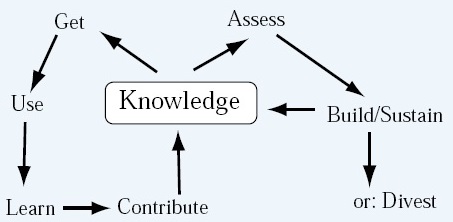Approaches to Knowledge Management Cycle

Knowledge Management (KM) is needed for an organization to help them identify, acquire, disseminate, and capture the benefits of each knowledge to build an effective strategy for the organization. To be able organizing knowledge, we need to do some major steps in Knowledge Management (KM) cycle. These cycles contain detail description of what to do in each step of the cycle. There are four major KM cycle, which are Meyer and Zack (1996), Bukowitz and Williams (2000), McElroy (1999, 2003), and Wiig (1993). From each of these cycles, they have their own steps and descriptions to finishing the cycle.
- Meyer and Zack (1996)
This approach gives lessons that the work of design and development of information products can be applied to the management of knowledge assets. It means the design of physical products can be used as the basis of KM cycle. The physical products in this cycle can be explained by numbers of product platform or can be called as knowledge repository, and process platform that is used for to leverage knowledge in an organization. This cycle’s stages consist of creation of knowledge product of well-designed repository. Meyer and Zack analyzed that a well-designed repository or database can be the basic or foundation of a firm information and knowledge management. The cycle in Meyer and Zack consists of several stages, which are acquisition, refinement, storage, distribution, and presentation.
- Bukowitz and Williams (2000)
For Bukowitz and Williams cycle, it consists of framework that help organization to generate, maintain, and deploy a strategic knowledge to create value. This cycle framework focusing on knowledge repositories, relationships, information technologies, communications infrastructures, functional skill sets, process know-how, environmental responsiveness, organizational intelligence, and external sources. Below is the figure of KM cycle from Bukowitz and Williams. The first three steps, which are get, learn, and contribute are affected by day-to-day use of knowledge. As for the next three steps, which are asses, build, and divest are triggered by macro environment.
- McElroy (1999,2003)
This McElroy cycle consists of processes of knowledge production and integration. In this cycle, McElroy emphasizes that knowledge must be held by both individual and group inside the organization, therefore they can make result from the knowledge distribution and reinforce existing knowledge to have the expected outcome. Hereby is the processes in McElroy KM cycle.
- Wiig (1993)
Wiig emphasizes on three things an organization must have to conduct a business, which are, must have products and services, customers, and resources. This cycle tells us about how the knowledge is built and used for individuals and organization. It focuses on identifying and analyzing activities that related to the knowledge building and sharing.
Wiig also focusing on giving the detailed activities can be done in each knowledge process, so the knowledge can be fully used to achieve the expected value of the organization.





